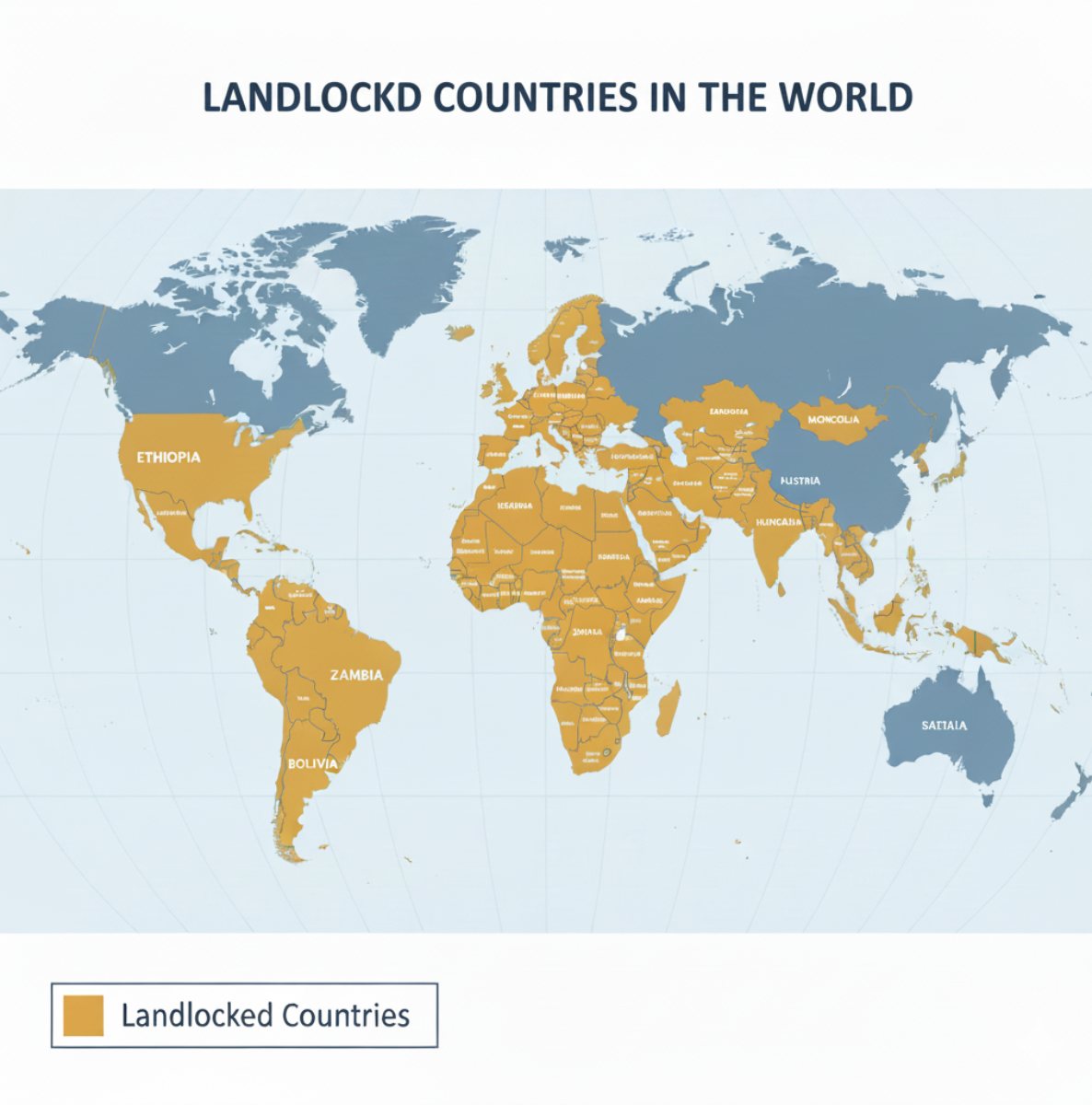Key Points
- There are 44 universally recognized landlocked countries across Africa, Asia, Europe, and South America, meaning they have no direct access to an ocean.
- The largest landlocked nation by area is Kazakhstan, while the smallest is Vatican City, and Uzbekistan and Liechtenstein are unique "double-landlocked" countries.
- Being landlocked poses economic challenges due to increased costs and slower transportation of goods, but these countries remain significant global participants.
List of Landlocked Countries: A landlocked country is a nation that does not have a direct access to the any ocean or any open sea. Basically, these countries are surrounded by land on all sides, means they have to rely on their neighbours for access to global trade routes and seaports. For example, Kazakhstan in Central Asia has no coastline, and while it borders the Caspian Sea, that sea itself is landlocked; it does not connect to the world’s oceans. On the other end of the scale, Vatican City is the smallest landlocked country in the world, located within the city of Rome, Italy.
Being landlocked can bring serious challenges, because without a seaport, countries have to pay extra for transporting goods through other nations. This often makes trade even more expensive and slower.
How Many Landlocked Countries Are There in the World?
There are 44 universally recognized landlocked countries in the world, meaning they do not have direct access to an open ocean. These countries are found across Africa, Asia, Europe, and South America. The largest landlocked country by area is Kazakhstan, located in Central Asia, while the most populated is Ethiopia, in Africa. At the opposite end of the spectrum, the smallest and least populated landlocked country is Vatican City, which is surrounded by Italy. A rare and distinct category includes the two "double-landlocked" countries, Liechtenstein and Uzbekistan, which are surrounded only by other landlocked nations.

List of Landlocked Countries
Here is a list of all the landlocked countries in the world:
| Country | Area (sq km) | Continent |
| Kazakhstan | 2,724,900 | Asia |
| Mongolia | 1,564,116 | Asia |
| Chad | 1,284,000 | Africa |
| Niger | 1,267,000 | Africa |
| Mali | 1,241,238 | Africa |
| Ethiopia | 1,120,000 | Africa |
| Bolivia | 1,098,581 | South America |
| Zambia | 752,612 | Africa |
| Afghanistan | 652,867 | Asia |
| South Sudan | 644,329 | Africa |
| Central African Republic | 622,436 | Africa |
| Botswana | 570,162 | Africa |
| Turkmenistan | 491,210 | Asia |
| Uzbekistan | 448,971 | Asia |
| Paraguay | 406,752 | South America |
| Zimbabwe | 390,757 | Africa |
| Burkina Faso | 270,764 | Africa |
| Uganda | 241,553 | Africa |
| Laos | 236,800 | Asia |
| Belarus | 207,629 | Europe |
| Kyrgyzstan | 199,945 | Asia |
| Nepal | 147,181 | Asia |
| Tajikistan | 141,400 | Asia |
| Malawi | 118,760 | Africa |
| Hungary | 93,023 | Europe |
| Azerbaijan | 86,600 | Asia |
| Austria | 83,884 | Europe |
| Czech Republic | 78,870 | Europe |
| Serbia | 77,589 | Europe |
| Slovakia | 49,034 | Europe |
| Switzerland | 41,291 | Europe |
| Bhutan | 38,394 | Asia |
| Moldova | 33,843 | Europe |
| Lesotho | 30,355 | Africa |
| Armenia | 29,743 | Asia |
| Burundi | 27,834 | Africa |
| Rwanda | 26,338 | Africa |
| North Macedonia | 25,436 | Europe |
| Eswatini | 17,364 | Africa |
| Luxembourg | 2,586 | Europe |
| Andorra | 468 | Europe |
| Liechtenstein | 160 | Europe |
| San Marino | 61 | Europe |
| Vatican City | 0.44 | Europe |
Check out: Top 10 States in India with Highest Daily Salary
What are the 12 landlocked countries in Asia?
Asia has twelve landlocked countries, means they are completely surrounded by land and have no direct access to an ocean. These countries are: Afghanistan, Armenia, Azerbaijan, Bhutan, Kazakhstan, Kyrgyzstan, Laos, Mongolia, Nepal, Tajikistan, Turkmenistan, and Uzbekistan. Most of these countries are located in Central Asia. Notably, Kazakhstan, Turkmenistan, and Azerbaijan border the landlocked Caspian Sea, which is considered the world's largest lake, not an ocean-accessible sea, and thus does not change their landlocked status. Uzbekistan is uniquely considered a "double-landlocked" country, as it is surrounded entirely by other landlocked countries.
Conclusion
Even though these 44 countries don’t have coastlines, they play a big part in world trade, culture, and politics. From the bustling cities of Ethiopia to the peaceful mountains of Switzerland, each landlocked country shows how humans can adapt and thrive, no matter what the map says.
Enter your Blink text here...
Comments
All Comments (0)
Join the conversation